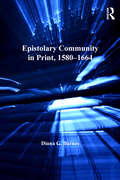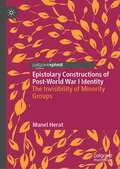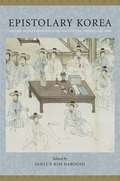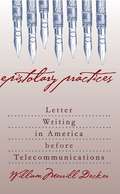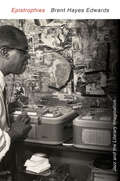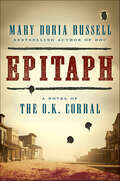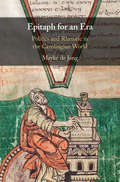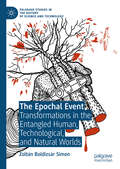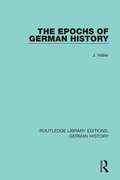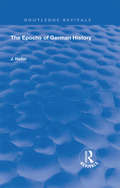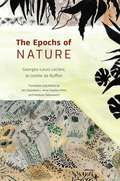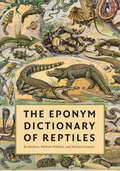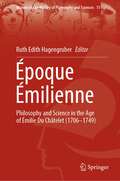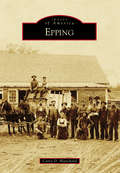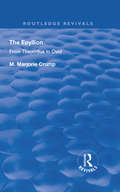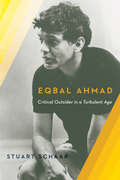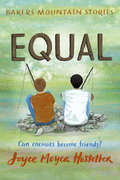- Table View
- List View
Epistolary Community in Print, 1580–1664 (Material Readings in Early Modern Culture)
by Diana G. BarnesEpistolary Community in Print contends that the printed letter is an inherently sociable genre ideally suited to the theorisation of community in early modern England. In manual, prose or poetic form, printed letter collections make private matters public, and in so doing reveal, first how tenuous is the divide between these two realms in the early modern period and, second, how each collection helps to constitute particular communities of readers. Consequently, as Epistolary Community details, epistolary visions of community were gendered. This book provides a genealogy of epistolary discourse beginning with an introductory discussion of Gabriel Harvey and Edmund Spenser’s Wise and Wittie Letters (1580), and opening into chapters on six printed letter collections generated at times of political change. Among the authors whose letters are examined are Angel Day, Michael Drayton, Jacques du Bosque and Margaret Cavendish. Epistolary Community identifies broad patterns that were taking shape, and constantly morphing, in English printed letters from 1580 to 1664, and then considers how the six examples of printed letters selected for discussion manipulate this generic tradition to articulate ideas of community under specific historical and political circumstances. This study makes a substantial contribution to the rapidly growing field of early modern letters, and demonstrates how the field impacts our understanding of political discourses in circulation between 1580 and 1664, early modern women’s writing, print culture and rhetoric.
Epistolary Constructions of Post-World War I Identity: The Invisibility of Minority Groups
by Manel HeratThis book analyses the letters of marginalised groups of World War I soldiers - including Black, Indian and disabled ex-servicemen - from a linguistic perspective, looking at issues such as descriptions of disability, identity and migration, dealing with minority groups who have long been rendered invisible, and exploring how these writers position themselves in relation to the 'other'. The author makes use of a corpus-assisted approach to examine identity construction and performance, shedding light on a previously under-explored demographic. This book will be of interest to students and scholars of World War I history, language and identity, psychological and physical disability, as well as readers seeking a fresh angle on a key period of 20th century history.
Epistolary Korea: Letters in the Communicative Space of the Chosôn, 1392-1910
by Jahyun Kim HaboushBy expanding the definition of "epistle" to include any writing that addresses the intended receiver directly, JaHyun Kim Haboush introduces readers to the rich epistolary practice of Chos?n Korea. The Chos?n dynasty (1392-1910) produced an abundance of epistles, writings that mirror the genres of neighboring countries (especially China) while retaining their own specific historical trajectory. Written in both literary Chinese and vernacular Korean, the writings collected here range from royal public edicts to private letters, a fascinating array that blurs the line between classical and everyday language and the divisions between men and women. Haboush's selections also recast the relationship between epistolography and the concept of public and private space.Haboush groups her epistles according to where they were written and read: public letters, letters to colleagues and friends, social letters, and family letters. Then she arranges them according to occasion: letters on leaving home, deathbed letters, letters of fiction, and letters to the dead. She examines the mechanics of epistles, their communicative space, and their cultural and political meaning. With its wholly unique collection of materials, Epistolary Korea produces more than a vivid chronicle of pre- and early modern Korean life. It breaks new ground in establishing the terms of a distinct, non-European form of epistolography.
Epistolary Korea: Letters in the Communicative Space of the Choson, 1392-1910
by Jahyun Kim HaboushBy expanding the definition of "epistle" to include any writing that addresses the intended receiver directly, JaHyun Kim Haboush introduces readers to the rich epistolary practice of Choson Korea. The Choson dynasty (1392-1910) produced an abundance of epistles, writings that mirror the genres of neighboring countries (especially China) while retaining their own specific historical trajectory. Written in both literary Chinese and vernacular Korean, the writings collected here range from royal public edicts to private letters, a fascinating array that blurs the line between classical and everyday language and the divisions between men and women. Haboush's selections also recast the relationship between epistolography and the concept of public and private space. Haboush groups her epistles according to where they were written and read: public letters, letters to colleagues and friends, social letters, and family letters. Then she arranges them according to occasion: letters on leaving home, deathbed letters, letters of fiction, and letters to the dead. She examines the mechanics of epistles, their communicative space, and their cultural and political meaning. With its wholly unique collection of materials, Epistolary Korea produces more than a vivid chronicle of pre- and early modern Korean life. It breaks new ground in establishing the terms of a distinct, non-European form of epistolography.
Epistolary Practices
by William Merrill DeckerLetters have long been read as primary sources for biography andhistory, but their performative, fictive, and textual dimensionshave only recently attracted serious notice. In this book, William Merrill Decker examines the place of the personal letter in American popular and literary culture from the colonial to thepostmodern period. After offering an overview of the genre, Decker explores epistolary practices that coincide with American experiences ofspace, settlement, separation, and reunion. He discusses letterswritten by such well-known and well-educated persons as JohnWinthrop, Benjamin Franklin, Thomas Jefferson, Abigail and JohnAdams, Nathaniel Hawthorne, Margaret Fuller, Henry David Thoreau, Samuel Clemens, Henry James, and Alice James, but also letters by persons who, except in their correspondence, were not writers at all: indentured servants, New England factory workers, slaves, soldiers, and Western pioneers. Individual chapters explore the letter writing of Ralph Waldo Emerson, Emily Dickinson, and Henry Adams--three of America's most ambitious, accomplished, and theoretically astute letter writers. Finally, Decker considers the ongoing transformation of letter writing in the electronic age.
Epistrophies: Jazz and the Literary Imagination
by Brent Hayes EdwardsHearing across media is the source of innovation in a uniquely African American sphere of art-making and performance, Brent Hayes Edwards writes. He explores this fertile interface through case studies in jazz literature—both writings informed by music and the surprisingly large body of writing by jazz musicians themselves.
Epistrophies: Jazz And The Literary Imagination
by Brent Hayes EdwardsHearing across media is the source of innovation in a uniquely African American sphere of art-making and performance, Brent Hayes Edwards writes. He explores this fertile interface through case studies in jazz literature—both writings informed by music and the surprisingly large body of writing by jazz musicians themselves.
Epitaph: A Novel of the O.K. Corral
by Mary Doria RussellMary Doria Russell, the bestselling, award-winning author of The Sparrow, returns with Epitaph. An American Iliad, this richly detailed and meticulously researched historical novel continues the story she began in Doc, following Wyatt Earp and Doc Holliday to Tombstone, Arizona, and to the gunfight at the O.K. Corral.A deeply divided nation. Vicious politics. A shamelessly partisan media. A president loathed by half the populace. Smuggling and gang warfare along the Mexican border. Armed citizens willing to stand their ground and take law into their own hands. . . . That was America in 1881.All those forces came to bear on the afternoon of October 26 when Doc Holliday and the Earp brothers faced off against the Clantons and the McLaurys in Tombstone, Arizona. It should have been a simple misdemeanor arrest. Thirty seconds and thirty bullets later, three officers were wounded and three citizens lay dead in the dirt.Wyatt Earp was the last man standing, the only one unscathed. The lies began before the smoke cleared, but the gunfight at the O.K. Corral would soon become central to American beliefs about the Old West.Epitaph tells Wyatt’s real story, unearthing the Homeric tragedy buried under 130 years of mythology, misrepresentation, and sheer indifference to fact. Epic and intimate, this novel gives voice to the real men and women whose lives were changed forever by those fatal thirty seconds in Tombstone. At its heart is the woman behind the myth: Josephine Sarah Marcus, who loved Wyatt Earp for forty-nine years and who carefully chipped away at the truth until she had crafted the heroic legend that would become the epitaph her husband deserved.
Epitaph for an Era: Politics and Rhetoric in the Carolingian World
by Mayke de JongWala, abbot of Corbie, played a major role in the rebellions against Emperor Louis the Pious, especially in 830, for which he was exiled. Radbert defended his beloved abbot, known to his monks as Arsenius, against accusations of infidelity in an 'epitaph' (funeral oration), composed as a two-book conversation between himself and other monks of Corbie. Whereas the restrained first book of Radbert's Epitaphium Arsenii was written not long after Wala's death in 836, the polemical second book was added some twenty years later. This outspoken sequel covers the early 830s, yet it mostly addresses the political issues of the 850s, as well as Radbert's personal predicament. In Epitaph for an Era, an absorbing study of this fascinating text, Mayke de Jong examines the context of the Epitaphium's two books, the use of hindsight as a rhetorical strategy, and the articulation of notions of the public good in the mid-ninth century.
Epitaph for Three Women (Plantagenet Saga #12)
by Jean Plaidy('The twelfth in the Plantagenet Saga) Henry V had died leaving a nine-month-old son as King of England. Before his death he had married Katherine of Valois, daughter of the French King, and according to the peace terms he had made with France, on the death of poor, mad Charles VI, he was to have been crowned King of France. Ambitious men surrounded the baby King, chief of whom were the child's uncles, the Dukes of Bedford and Gloucester.Bedford, shrewd, clever, born to be a leader, had idolized his brother, the late King, and sought to hold together all he had won and to keep it for young Henry VI. Gloucester, man of letters though he was, had poor judgment; greedy for wealth and power, he was frequently engaged in lost causes and throughout his life kept a feud with his uncle the powerful Cardinal Beaufort. There were three women living at this time who were to have a marked effect on the future. One of these was Katherine de Valois who, haunted by memories of an unhappy childhood overshadowed by a mad father and a rapacious and lascivious mother, discovered romantic happiness in an unexpected quarter and founded the Tudor dynasty. Then in complete contrast there was the peasant girl from Domremy. When Joan of Arc tending her father's flocks heard heavenly voices commanding her to lead France to victory, she thought she was dreaming. But eventually, convinced that she must obey her voices, she was caught up in one of the most amazing experiences ever recorded which took her from the pastures of her village to fiery martyrdom in the square of Rouen. Eleanor of Gloucester's affairs were less spectacular but she, too, wielded a certain power. First the Duke's mistress she plotted to become his Duchess and her influence was considerable until she became involved in a plot to murder and was the centre of a cause celebre. Against a background of Lancastrian England and war- torn France, with ambitious men juggling for power, with feuds between Beaufort and Gloucester and the Duke of Burgundy and King Charles of France, the picture slowly changes. The defeated became the victorious in those turbulent times when murder, greed and ruthless ambition flourished side by side with courage, dedication and martyrdom.
The Epochal Event: Transformations in the Entangled Human, Technological, and Natural Worlds (Palgrave Studies in the History of Science and Technology)
by Zoltán Boldizsár SimonThis book is a unique attempt to capture the growing societal experience of living in an age unlike anything the world has ever seen. Fueled by the perception of acquiring unprecedented powers through technologies that entangle the human and the natural worlds, human beings have become agents of a new kind of transformative event. The ongoing sixth mass extinction of species, the prospect of a technological singularity, and the potential crossing of planetary boundaries are expected to trigger transformations on a planetary scale that we deem catastrophic and try to avoid. In making sense of these prospects, Simon’s book sketches the rise of a new epochal thinking, introduces the epochal event as an emerging category of a renewed historical thought, and makes the case for the necessity of bringing together the work of the human and the natural sciences in developing knowledge of a more-than-human world.
The Epochs of German History (Routledge Library Editions: German History #18)
by J. HallerOriginally published in 1930 this book discusses the critical moments in German history, with a view to surveying the development of the German nation and an attempt to understand the events of the 1920s with reference to significant chapters in Germany history from the past.
The Epochs of German History (Routledge Revivals #18)
by J. HallerOriginally published in 1930. This book is not intended to be a discussion on German history, but to talk about its epochs, a period in which some fresh beginning is made, some fresh determining element enters, some event occurs to give a new direction to the course of history. The book is concerned with the critical moments of German history, the turning points in its course. Those are what we want to consider, wnd also to select as points of vantage from which we may survey the development of the German nation, viewing the panorama section by section.
The Epochs of Nature
by Georges-Louis Leclerc Jan Zalasiewicz Anne-Sophie Milon Mateusz Zalasiewicz Sverker Sörlin Libby Robin Jacques GrinevaldGeorges-Louis Leclerc, le comte de Buffon's The Epochs of Nature, originally published as Les Époques de la Nature in 1778, is one of the first great popular science books, a work of style and insight that was devoured by Catherine the Great of Russia and influenced Humboldt, Darwin, Lyell, Vernadsky, and many other renowned scientists. It is the first geological history of the world, stretching from the Earth’s origins to its foreseen end, and though Buffon was limited by the scientific knowledge of his era—the substance of the Earth was not, as he asserts, dragged out of the sun by a giant comet, nor is the sun’s heat generated by tidal forces—many of his deductions appear today as startling insights. And yet, The Epochs of Nature has never before been available in its entirety in English—until now. In seven epochs, Buffon reveals the main features of an evolving Earth, from its hard rock substrate to the sedimentary layers on top, from the minerals and fossils found within these layers to volcanoes, earthquakes, and rises and falls in sea level—and he even touches on age-old mysteries like why the sun shines. In one of many moments of striking scientific prescience, Buffon details evidence for species extinction a generation before Cuvier’s more famous assertion of the phenomenon. His seventh and final epoch does nothing less than offer the first geological glimpse of the idea that humans are altering the very foundations of the Earth—an idea of remarkable resonance as we debate the designation of another epoch: the Anthropocene. Also featuring Buffon’s extensive “Notes Justificatives,” in which he offers further evidence to support his assertions (and discusses vanished monstrous North American beasts—what we know as mastodons—as well as the potential existence of human giants), plus an enlightening introduction by editor and translator Jan Zalasiewicz and historians of science Sverker Sörlin, Libby Robin, and Jacques Grinevald, this extraordinary new translation revives Buffon’s quite literally groundbreaking work for a new age.
The Eponym Dictionary of Reptiles
by Bo Beolens Michael Watkins Michael GraysonWho was Richard Kemp, after whom the Kemp’s ridley sea turtle is named? Is Wake’s Gecko named after Berkeley’s Marvalee Wake? Or perhaps her husband, David? Why do so many snakes and lizards have Werner in their name? This reference book answers these and thousands of other questions about the origins of the vernacular and scientific names of reptiles across the globe.From Agkistrodon piscivorus conanti, the Florida cottonmouth subspecies named for Roger Conant, to Xantusia, the night lizard genera namesake of John Xantus, this dictionary covers everyone after whom an extant or recently extinct reptile has been named. The entries include a brief bio-sketch, a list of the reptiles that bear the individual’s name, the names of reptiles erroneously thought to be associated with the person, and a summary of major—and sometimes obscure or even incidental—contributions made by the person to herpetology and zoology. An introductory chapter explains how to use the book and describes the process of naming taxa. Easy to use and filled with addictive—and highly useful—information about the people whose names will be carried into the future on the backs of the world’s reptiles, The Eponym Dictionary of Reptiles is a handy and fun book for professional and amateur herpetologists alike.
Époque Émilienne: Philosophy and Science in the Age of Émilie Du Châtelet (1706-1749) (Women in the History of Philosophy and Sciences #11)
by Ruth Edith HagengruberThe present book contextualizes Du Châtelet’s contribution to the philosophy of her time. The editor offers this tribute to an Époque Émiliennee as a collection of innovative papers on Emilie Du Châtelet’s powerful philosophy and legacy.Du Châtelet was an outstanding figure in the era she lived in. Her work and achievements were unique, though not an exception in the 18th century, which did not lack outstanding women. Her personal intellectual education, her scholarly network and her mental acumen were celebrated in her time, perceiving her to have “multiplied nine figures by nine figures in her head”. She was able to gain access to institutions which were normally denied to women. To call an epoch an Époque Émilienne may be seen as daring and audacious, but it will not be the last time if we continue to bring women philosophers back into the memory of the history of philosophy. The contributors paid attention to the philosophical state of the art, which forms the background to Du Châtelet’s philosophy. They follow the transformation of philosophical concepts under her pen and retrace the impact of her ideas. The book is of interest to scholars working in the history of philosophy as well as in gender studies. It is of special interest for scholars working on the 18th century, Kant, Leibniz, Wolff, Newton and the European Enlightenment.
Epping (Images of America)
by Corey BlanchardWith its lush forests, fertile land, and abundant waterways, Epping began attracting European settlers as early as 1710 before incorporating as an independent town in 1741. The town became home to successful farms, lumber operations, and mills built along the Lamprey River. Clay that lay beneath the fertile soil emerged as an important resource when commercial brickyards began popping up all over town in 1822. Epping became a crossroads for multiple rail lines, which spurred economic development and population booms. In 1862, undeveloped land became home to the Methodist campground Camp Hedding. Factories, especially those specializing in shoes, were established in the area as well. Epping's industrial concerns lasted until the late 20th century, when it grew as a retail center at the junction of Routes 101 and 125. Epping has been home to prominent residents, including a Revolutionary War general, three New Hampshire governors, a world heavyweight boxing champion, the first person to circumnavigate the world on a motorcycle, and a female collegiate basketball great.
EPS 12 Aitihaasik Prshthabhoomi (1) IGNOU
by Ignou Firstname SurnameAitihaasik Prshthabhoomi is a Block 1 Of EPS 12 which contains the following Chapters. 1. Upaniveshavaad ke Prabhaav 2. Bhaarateey Samaaj kee Pratikriyaen 3. Raashtreey Aandolan 4.Nae Vargon Ka Udyagaman
EPS 12 Bharat Mein Daleey Pranaalee Aur Nirvaachan (5) IGNOU
by IgnouEPS 12 Bhaarat Mein Daleey Pranaalee Aur Nirvaachan (5) is a history book which is 5th block of EPS (12) it contains the following chapters. 19. Bharat Mein Daleey Pranaalee Kee Prakrti 20. Raashtreey Tatha Kshetreey Dal 21. Chunaav 22. Jaati, Varg Tatha Rajneeti 23. Gathabandhan Kee Rajneeti
EPS 12 Bharat Mein Sanghavaad (4) IGNOU
by IgnouEPS 12 Bharat Mein Sanghavaad (4) is a history book which contains the following chapters;- 14. Bhaarateey Sanghavaad Ka Swaroop. 15. Uttar-Poorvee Raajyon, Jammoo Evam Kashmir Aadi Ke Lie Vishesh Dhaaraen. 16. Bhaarateey Sanghavaad Mein Takaraav Evan Sahayog Ke Mudde. 17. Bharat Mein Svaayattata Aandolan Aur Raajyon Ka Punargathan. 18. Sthaaneey Svashaasan Sansthaen: Graameen Evam Shahari.
EPS-12 Bhartiya Samvidhan Ka Tatvagyan (2) IGNOU
by IgnouEPS 12 Bhartiya Samvidhan Ka Tatvagyan (1) is a history book which contains the following chapters. 5. Bhaarateey Sanvidhaan Kee Rachana. 6. Pramukh Abhilakshan. 7.Saamaajik Roopaantaran Ka Avalokan. 8. Adhikaar Aur Naagarikata
EPS 12 Sansthanika Pradhara (3) IGNOU
by IgnouEPS 12 Sansthanika Pradhara (3) is a history book which contains the following chapters. 9. Ek Sansadeey Lokatantr Hone Ka Arth. 10. Vidhaayika. 11.Kaaryapaalika. 12. Nyaayapaalika. 13. Naukarashaahee
The Epyllion: From Theocritus to Ovid (Routledge Revivals)
by M. Marjorie CrumpPublished in 1931: The Epyllion From Theocritus to Ovid discusses Greek Epics along with extracts of Poems.
Eqbal Ahmad: Critical Outsider in a Turbulent Age
by Stuart SchaarEqbal Ahmad (1930?–1999) was a bold and original activist, journalist, and theorist who brought uncommon perspective to the rise of militant Islam, the conflict in Kashmir, the involvement of the United States in Vietnam, and the geopolitics of the Cold War. A long-time friend and intellectual collaborator of Ahmad, Stuart Schaar presents in this book previously unseen materials by and about his colleague, having traveled through the United States, India, Pakistan, western Europe, and North Africa to connect Ahmad's experiences to the major currents of modern history.Ahmad was the first to recognize that former ally Osama bin Laden would turn against the United States. He anticipated the rapidly shifting loyalties of terrorists and understood that overthrowing Saddam Hussein would provoke violence and sectarian strife in Iraq. Ahmad had great compassion for the victims of the proxy wars waged by the leading Cold War powers, and he frequently championed unpopular causes, such as the need to extend the rights of Palestinians and protect Bosnians and Kosovars in a disintegrating Yugoslavia. Toward the end of his life, Ahmad worked tirelessly to broker a peace between India and Pakistan and to prevent the spread of nuclear weapons throughout the subcontinent. As novel and necessary as ever, Ahmad's remarkable vision is here preserved and extended to reveal the extent to which he was involved in the political and historical conflicts of his time.
Equal
by Joyce Moyer HostetterHere is a riveting coming-of-age story about the importance of staying true to yourself and the essential power of friendship in this fifth and final title in the popular Bakers Mountain Stories series.It's the summer of 1959 at the foot of Bakers Mountain in western North Carolina when 13-year-old Jackie Honeycutt first bumps into Thomas Freeman fishing on the riverbank. They hit it off, and Jackie hopes the two of them can be friends. But Jackie is white, and Thomas is Black -- and Jackie quickly learns their growing friendship won't be easy. North Carolina is the focus of the growing civil rights movement, and through his friendship with Thomas, Jackie experiences racism and prejudice first-hand through bullying at school, family turmoil and pressure from his community. Can Jackie free both his conscience and his voice - and ultimately do what's right?
